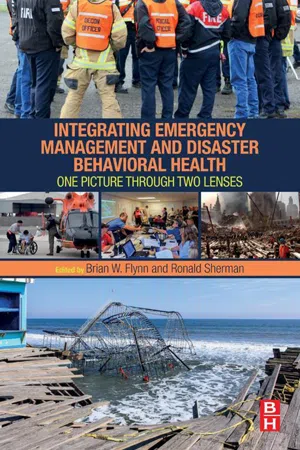
Integrating Emergency Management and Disaster Behavioral Health
One Picture through Two Lenses
- 370 pages
- English
- ePUB (mobile friendly)
- Available on iOS & Android
Integrating Emergency Management and Disaster Behavioral Health
One Picture through Two Lenses
About this book
Integrating Emergency Management and Disaster Behavioral Health identifies the most critical areas of integration between the profession of emergency management and the specialty of disaster behavioral health, providing perspectives from both of these critical areas, and also including very practical advice and examples on how to address key topics.Each chapter features primary text written by a subject matter expert from a related field that is accompanied by a comment by another profession that is then illustrated with a case study of, or a suggested method for, collaboration.- Addresses the current state of the collaboration between the emergency management and disaster behavioral health communities as presented from pioneers in their respective fields- Focuses on practical examples of what works and what doesn't- Stresses both legal and ethical considerations and the public-private partnerships that are important for leadership in disaster situations- Covers Emergency Operations Centers (EOCs) and risk communication
Frequently asked questions
- Essential is ideal for learners and professionals who enjoy exploring a wide range of subjects. Access the Essential Library with 800,000+ trusted titles and best-sellers across business, personal growth, and the humanities. Includes unlimited reading time and Standard Read Aloud voice.
- Complete: Perfect for advanced learners and researchers needing full, unrestricted access. Unlock 1.4M+ books across hundreds of subjects, including academic and specialized titles. The Complete Plan also includes advanced features like Premium Read Aloud and Research Assistant.
Please note we cannot support devices running on iOS 13 and Android 7 or earlier. Learn more about using the app.
Information
Section II. Key Areas of Integration
Integration in Disasters of Different Types, Severity, and Location
Abstract
Keywords
Through a Disaster Behavioral Health Lens
Complex Systems Thinking for EM and DBH Integration in Disasters
Different Levels of Disaster Response
The Event Dictates the Level of EM Response
• Crisis | Capacities exceed demands—with capacity to spare. |
• Emergency | Capacities meet (and may somewhat exceed) demands. |
• Disaster | Demands exceed capacities. Outside help is needed and may direct the event. |
• Catastrophe | Demands overwhelm and obliterate capacities. Outside help takes over direction of the event by default. |
Table of contents
- Cover image
- Title page
- Table of Contents
- Copyright
- Dedication
- List of Contributors
- Acknowledgments
- Introduction
- Section I: Context
- Section II: Key Areas of Integration
- Section III: Special Opportunities to Enhance Integration
- Index
